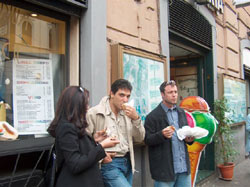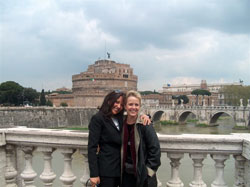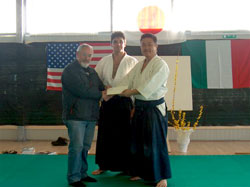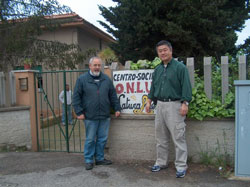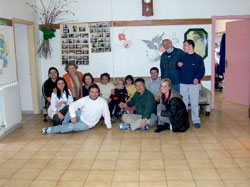My first visit to Italy this April 2004 was hosted by Samuel Onofri Sensei and his wife Aurora of Nettuno. Through the narrow streets of Rome they guided us, steering us skillfully through throngs of lost tourists and busy natives. It was a testimonial to their native prowess, they were very good ! Using both hands to gesture in typical Italian fashion, they patiently explained about the local architecture, history, foods, and all of the nuances of the local population. Explaining about the many ruins in and about Rome, Samuel explained that they were “very, very, very old”. Most descriptions had at least three “very’s” in front of them, and rightly so! We stood in awe at ruins that had histories that began before the time of Christ. They were indeed “very, very, very old”! In one part of Rome, I stood admiring a particular ruin. “This one is new” Samuel commented. “It is only 500 years old”!
- Samuel Onofri Sensei at his favorite ice cream shop in Rome. Center: Samuel Sensei, right: Rick Thompson
- Aurora and Emily, AHAN President.
During this visit we stayed about one hour southwest of Rome in the port town of Anzio. Anzio is home to ruins of its own as the place that the infamous Emperor Nero had one of his summer palaces. A destination for Roman natives’ more than foreign tourists, Anzio exudes a quaint charm. Even over the busy Easter holiday, visitors strolled slowly arm and arm down walkways by the sea. Older couples lingered over cappuccinos at local restaurants engrossed in discussion, Italian style. Anzio was a sleepy seaside town with a charming pace. The local innkeepers were very kind to us, once they figured out that although quite illiterate in Italian we were quite harmless. The local restaurants, we soon discovered did not open for dinner until 8:00 pm. Venturing out for a meal without our hosts at times, we were greeted warmly and ushered to our table with grand gestures of welcome. The guests around us dined on local fresh sea foods and garden vegetables flavored simply with olive oil, vinegar and garlic. We learned that an Italian dinner begins with a course of antipasto (appetizers) followed by courses of pasta or pizza and main courses of fish or meat dishes. All of the courses were accompanied by wonderful Italian wines which flowed freely. I really think that the people of Italy must have an extra stomach to have for room for all of this plus a variety of exotic deserts and coffees! As I looked around however, I did not really see anyone who looked like they needed to go on a diet. It made me question the validity of the most popular new low carb diet craze in the United States. Here in Italy I was impressed by how everyone enjoyed their mealtimes, enjoying well balanced, natural foods accompanied by ample amounts of joy and comradery. I decided to follow the old saying, “When in Rome… and joined right in!
At the invitation of Samuel Onofri Sensei of Kihon dojo in Nettuno, we came to Italy to conduct this fundraising seminar for the Naturalment Centro-Sociale O.N.L.U.S. This center is a non-profit organization that provides day care, activities, meals and therapy for children and young adults with mental disabilities such as autism and turret syndrome. This first visit to Italy was very successful, and we laid much groundwork and completed research for future AHAN (Nippon Kan’s Aikido Humanitarian Active Network) fundraising projects in Italy for 2005. Approximately forty Aikidoka from the Nettuno area gathered for this groundbreaking seminar, and everyone practiced very diligently at a high technical level.
In the 1960’s Hiroshi Tada Shihan (currently Aikikai Hombu 9th Dan) was sent by Aikikai Hombu headquarters in Japan to Italy. Through his efforts over these many decades, Aikido is practiced widely in Italy, and the students that attended this seminar reflected his level of expertise. I highly respect what Tada Shihan has accomplished in Italy.
All seminar fees collected were donated to the Naturalmente Centro-Sociale center. To keep seminar costs minimal my travel and lodging expenses and the expenses of accompanying Nippon Kan staff were covered by AHAN and not by seminar proceeds. All instructional fees were also waived and donated back to the project.
At this seminar, raising money was not the only target or purpose. In our communities there are many individuals and organizations that do good work for others but remain out of the spotlight. This seminar was an opportunity to shine a small light on this center, bringing its goals and purpose to a forefront. So the purpose of the seminar then was not only to raise funds, but to raise awareness as well. This kind of community awareness is just as important as the funds raised for the future of the center.
AHAN supports humanitarian projects in many parts of the world and the projects that are selected are almost always projects that do not receive a lot of attention from government or corporate sponsors. There is always an organization that can be found that does not have the power or resources to mount massive fundraising or support campaigns. We relied on the judgment of Samuel Sensei and his wife, and they found a project of great merit in need of our help. Through this seminar we were able to practice Aikido for our enjoyment and also were able to help others at the same time. This project of support for the Naturalmente Centro-Sociale began this year with Kihon dojo, and with Kihon dojo at the helm we hope to expand the project next year!
- Homma Kancho (right) gives donation to Mr. Mauro, President of the Center (left).
- In front of Center.
This visit to Italy also had another special meaning for me. In the almost three decades that I have lived in the United States, there have been three Italian Americans who have had a major effect on my life…
The late Tony Graziano Sensei was a respected police officer, leader of the Brevard County Sheriffs SWAT team and dojo cho of Melbourne Aikikai in Melbourne, Florida. I met Tony back in the early days of my career teaching Aikido in the United States. Back in those days, Nippon Kan was quite small, and there were many times I was not sure if there would be any food to put on the table that day. It was Tony Graziano Sensei who opened the door for me, and invited me to teach a seminar at his dojo in Florida, not once, but for seven consecutive years! As our relationship grew, Tony also visited Denver on occasion to attend our Nippon Kan seminars, accompanied at times by the late Dr. Tom Walker Sensei of Sand Drift Aikido. His spirit and loyalty were as sturdy as stone, and his friendship was invaluable to me. In 1994, Tony Graziano Sensei fell ill with esophageal cancer and endured many surgeries and other cancer treatments. Five days after his first major surgery (while the three foot incision in his back was still held together with metal staples), I visited Tony in his hospital room. He greeted me formally, sitting up straight and tall in bed, clad in a Japanese yukata (Japanese summer kimono). He used his bokken to hold himself still, and bowed graciously with a smile. You could see his determination not to falter, but his smile could not hide the pain in his eyes. The following year, Tony Graziano Sensei passed away on May 2, 1995. He will be remembered not only by me, but by all of the people that he touched.
Charles Deiro was one of my original students when I first began teaching in Denver. When I think back to those days, I remember that whenever I looked behind me, Charles was there. He is a little older than I, and on numerous occasions I asked for his advice and counsel. His answer to my queries was always the same, “You’re the boss, Sensei, I am just here to support you. Whatever you think is best”.
Charles too, like Tony is characterized by his loyalty and trustworthiness. In those days, as I have mentioned, I was not making a very decent living teaching Aikido, and it was Charles that gave me a job as a night janitor cleaning buildings so that I might survive. For many years, Charles was the Children’s Class Instructor at Nippon Kan. In the early 1990’s Charles and his family moved to Milwaukee to pursue new business opportunities where he still lives today. Charles’s dojo in Milwaukee is the only other dojo in the United States that holds Nippon Kan’s name. His son Edward now oversees dojo operations at Nippon Kan Wisconsin in Milwaukee.
Don Perotta now age 46, played a important role in Nippon Kan’s history in Denver. Don is still legendary for his positive attitude and caring disposition; everyone likes Don! It was about nine years ago that Nippon Kan moved from our old location on Cherokee street to our current facility. It was a daunting task, that took almost two years to complete, and Don was there almost every day. The project began by tearing down reusable décor in the old dojo to be cataloged and packed for transport to the new facility. When the work began, Don pitched in, commenting nonchalantly “What the heck, I am not working right now anyway, I have a lot of time and would like to help”. I am not sure Don, or any of us for that matter knew the number of days we would be working from sunrise until the wee hours of the next morning without much of a break. Even though the work continued for over a year, Don never complained, nor did I ever see him wear the look of exasperation that adorned my face on a regular basis. He worked steadily, and constantly, and always with a smile. Except for being fed, Don worked completely as a volunteer and was never paid for all of the hours, weeks and months of work he put into the project.
The last part of the project was the completion of Nippon Kan’s restaurant “Domo”. The morning the restaurant was scheduled to open, Don took off the tool belt that he had worn daily for so many months and exchanged it for a manager’s uniform. With Don’s previous experience as a restaurant manager, we were able to open and begin operation of the restaurant successfully. During such a period of growth, and the trials that such growth brings, I grew to greatly admire and respect Don’s kindness, patience and sense of teamwork.
All three of these special people, never asked me for anything. Their loyalty, helpfulness and sincerity did not come with a price tag. Some day I always thought, I would be able to repay them, and this trip to Italy became part of a first step. Going to Italy, I wanted to see if I could discover what the secret was in their home country that made these three Italians such special people.
I went to Italy in one sense to show my appreciation for those from that country who had shown such kindness to me. I was lucky enough to meet Samuel Sensei and his wife Aurora and the other young Aikidoists in Italy in their steed who also held these special qualities. Through Samuel Sensei and Aurora, AHAN has found a new project that supports and helps children in their community, in their homeland of Italy. I was able to share my appreciation with them, completing a circle of appreciation that started decades ago. This way of the circle, like many things in my life, has been my style of appreciation.
I am now almost in my mid fifties. Looking back on my life, I have met so many different kinds of people. There have been people that stood out, and people that directly changed the direction of my life. These are the people I can’t forget. Thinking about it, I think everyone has people like this along their own paths in their own lives.
The fact that I have been practicing Aikido for forty years and have lived in the United States for 28 years is an accomplishment, but is an accomplishment that I could not have achieved alone. There have been so many that have helped me to survive. Looking back, not all of memories I have are positive, but even those people who affected me in a negative way, stimulated me and caused growth in my life. They were an inspiration too and helped me to learn through difficulties. To these people I also owe a debt of gratitude.
There are many kinds of demonstrations of appreciation. There is a direct show of appreciation as in the gift of a card, or a meal or a glass of sake. This kind of demonstration used to be possible for me when Nippon Kan was the size that I could know everyone by name. Now that Nippon Kan has grown, it is difficult to be able to show appreciation to everyone directly.
In Denver, there have been over 17,000 students that have taken the beginning Aikido courses at Nippon Kan. Over 17,000 students that have stood before me as I stood before them as their instructor standing day after day in front of the Founder’s photo on the Nippon Kan shrine. With so many that have passed before my eyes, it has been the students that have become instructors, staff members, senior club members and friends that have made it possible. Today Nippon Kan is staffed by about 35 volunteer instructors and office assistants. I did not bring them with me when I first arrived in the United States; it has taken a long time to build what Nippon Kan has become today.
A few years ago, I founded AHAN (the Aikido Humanitarian Active Network), the international humanitarian division of Nippon Kan operations. This small corner of Nippon Kan is dedicated to community volunteer services around the world. If you read the AHAN sections on the website, you can gain a better understanding of the work that AHAN is involved with. I began AHAN, as my way of giving back, as my style of appreciation to all of those who have helped me along the way.
It came to me as a realization that what I could give back was to build an organization whose activities would make someone proud to be a member. What I could give back would be Nippon Kan’s reputation and standing in our community. What began as a realization has become Nippon Kan and AHAN, and in only a few short years, hundreds of people have been involved in AHAN activities around the world. AHAN encourages people from all styles and affiliations to participate in AHAN activities of their own, and we now have many requests to visit dojos in countries all over the world. While I am still young enough and in good health, I have chosen the dojos who have contacted us from farthest away to visit first. This is one of the reasons why I have spent a great deal of time these past few years in countries like Mongolia, Brazil, Mexico, Czech Republic and now Italy.
The three Italian friends I have introduced to you in this article are special people among a vast number of special people I have known. I guess you could say, this article is the Italian edition of my article column! The sketch you see here is from the first book I published in the United States in 1988; Aikido for Life. This sketch expresses the feelings I have of appreciation; my style of appreciation. From the time this book was first published, (over sixteen years ago) until today, I believe that Nippon Kan has grown because it is based on a foundation of appreciation and the repayment of such kindness. This belief is the inspiration that still motivates me today. This is what I do and will continue to do…it is my style of appreciation.
Gaku Homma
Nippon Kan Kancho
April 27th, 2004


